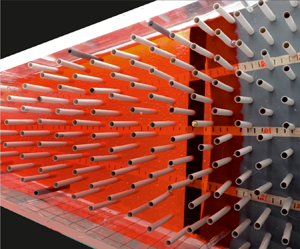Article contents
Experimental study on radial gravity currents flowing in a vegetated channel
Published online by Cambridge University Press: 06 January 2022
Abstract

We present an experimental study of gravity currents in a cylindrical geometry, in the presence of vegetation. Forty tests were performed with a brine advancing in a fresh water ambient fluid, in lock release, and with a constant and time-varying flow rate. The tank is a circular sector of angle  $30^\circ$ with radius equal to 180 cm. Two different densities of the vegetation were simulated by vertical plastic rods with diameter
$30^\circ$ with radius equal to 180 cm. Two different densities of the vegetation were simulated by vertical plastic rods with diameter  $D=1.6\ \textrm{cm}$. We marked the height of the current as a function of radius and time and the position of the front as a function of time. The results indicate a self-similar structure, with lateral profiles that after an initial adjustment collapse to a single curve in scaled variables. The propagation of the front is well described by a power law function of time. The existence of self-similarity on an experimental basis corroborates a simple theoretical model with the following assumptions: (i) the dominant balance is between buoyancy and drag, parameterized by a power law of the current velocity
$D=1.6\ \textrm{cm}$. We marked the height of the current as a function of radius and time and the position of the front as a function of time. The results indicate a self-similar structure, with lateral profiles that after an initial adjustment collapse to a single curve in scaled variables. The propagation of the front is well described by a power law function of time. The existence of self-similarity on an experimental basis corroborates a simple theoretical model with the following assumptions: (i) the dominant balance is between buoyancy and drag, parameterized by a power law of the current velocity  $\sim |u|^{\lambda-1}u$; (ii) the current advances in shallow-water conditions; and (iii) ambient-fluid dynamics is negligible. In order to evaluate the value of
$\sim |u|^{\lambda-1}u$; (ii) the current advances in shallow-water conditions; and (iii) ambient-fluid dynamics is negligible. In order to evaluate the value of  ${\lambda}$ (the only tuning parameter of the theoretical model), we performed two additional series of measurements. We found that
${\lambda}$ (the only tuning parameter of the theoretical model), we performed two additional series of measurements. We found that  $\lambda$ increased from 1 to 2 while the Reynolds number increased from 100 to approximately
$\lambda$ increased from 1 to 2 while the Reynolds number increased from 100 to approximately  $6\times10^3$, and the drag coefficient and the transition from
$6\times10^3$, and the drag coefficient and the transition from  $\lambda=1$ to
$\lambda=1$ to  $\lambda=2$ are quantitatively affected by D, but the structure of the model is not.
$\lambda=2$ are quantitatively affected by D, but the structure of the model is not.
Information
- Type
- JFM Papers
- Information
- Copyright
- © The Author(s), 2022. Published by Cambridge University Press
References
REFERENCES
- 4
- Cited by


